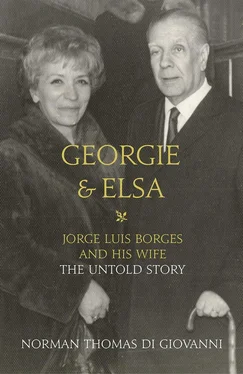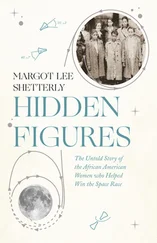For how long this went on we do not know. It has been claimed that they were sweethearts for two years and that there was even talk of marriage, but Elsa once remarked that she couldn’t remember if they were ever formally engaged. Interviewed in 1983, she spoke of having been Borges’s fiancée when she was twenty years old. ‘We had even exchanged rings,’ she said. ‘We were properly engaged.’
Again, taking the lead from Elsa, let us now say she was twenty. That would have made Borges thirty-one and the year 1930. She claimed that a besotted Borges journeyed to La Plata every Saturday to see his beloved. But what the beloved never revealed to him was that she had fallen in love with someone else, with whom she was carrying on a clandestine relationship. Borges, incredibly callow, was the last person to find out. One variant of the story quotes Elsa as saying that ‘A fortnight after I was married, Borges, who knew nothing about it, kept phoning my house. My mother did not know what to say to him, and I washed my hands of the matter. I told her it was her problem. Finally, being very correct, my mother answered one of his calls and said, “Look, Borges, pardon me, but I feel obliged to tell you something. Don’t phone any more; Elsa is married.”’ The mother reported that there was a short silence down the telephone and then Borges said, ‘ Ah , caramba ,’ and he hung up.
There is something amusing about this story, but it does Elsa no credit, while it makes an utter fool of Borges. Can things really have happened in this way? Was Elsa’s memory plainly unreliable or was she simply good at invention? When would these events have taken place? We know that Elsa was not married until 1937. Several years are unaccounted for here.
While there is no full or straightforward account of the romance there is no end of inconsequential variations. In one, María Millán, Elsa’s mother, ran a boarding house, where Borges stayed during his visits and where Henríquez Ureña was a lodger. It was here, not at the professor’s home nor at the Museum of Fine Arts, that Elsa first met Borges.
One thing only seems certain – that this was Borges’s first of several experiences of being deceived and jilted by a woman. What lesson did he derive from the Elsa misfortune?
In the whole fraught saga of his star-crossed relationship with Elsa, what happened next, early in 1944, must rank as one of the strangest turns in Borges’s life. By this time Elsa had been married since 1937 to one Ricardo Albarracín Sarmiento, by whom she had a son. In this seven-year interim she and Borges are not known to have been in contact. Under what circumstances then and by what plotting did he meet Elsa again? All we know is what he wrote to her in two love letters, both composed in the same week. These mysterious billets-doux, giving no hint of a before or an after, seem to have materialized out of nowhere, led nowhere, and ended nowhere.
The first of these impassioned letters, written on 31 January, reveals that Georgie and Elsa had met the day before, an encounter that unleashed a veritable Niagara of emotion in the normally buttoned-up Borges. Apart from his amatory outpourings, he says he would like to overwhelm her with a detailed description of his room, with his bookcase containing the Encyclopædia Britannica , his shelves of Chesterton’s works, and his various editions of the Arabian Nights. And he recommends that she read the anthology of fantastic literature that he had compiled a few years earlier with his friends Adolfo Bioy Casares and Silvina Ocampo.
In the second letter, written on 4 February, he tells Elsa that two days earlier he had gone to Sur , the leading literary magazine of the period, to correct the proofs of his latest short story and to add a dedication. The dedication was one he had obviously promised her when they met. Indeed when the issue of Sur appeared his tale bore the inscription ‘To E.H.M.’, initials standing for Elsa Helena Millán. The missive goes on to say that the Sunday editions of both Buenos Aires papers, La Prensa and La Nación , are reviewing a book of his poems. We learn that the following week he is going to ‘undertake a pilgrimage to La Plata.’ And he closes telling her that he is in the midst of correcting the final proofs of Sarmiento’s nineteenth-century classic Recuerdos de provincia , wherein her surname – that is, her husband’s surname, Albarracín – appears countless times, as well as revising Spanish translations of Carlyle and Emerson and completing ‘a long metaphysical essay for Sur .’
So much for the letters’ factual information. It is almost unbelievable that Borges would seek to impress or attempt to attract a young married woman with no literary interests whatsoever by reciting to her the contents of his library shelves or the trivia of his proofreading, editing, or writing activities. The dedication, yes, may have proved momentarily flattering, but the rest in a man of forty-four is more like the hopeful but clumsy groping and fumbling of an adolescent.
More revealing are the overblown expressions of love. ‘To have witnessed the birth and death of your slow smile, to have heard the precious modulations of your voice, to have recaptured for a few hours the intricate delight of your company …’ He then tells Elsa she is not just a miracle but is also indispensable, and he begs her not to go out of his life. On it goes; each bit of his soul-baring, each of his declarations, more embarrassing than the last. ‘Those who suffer the misfortune of not being Helena Astete Millán have no reality for me …’
What on earth could have provoked these pathetic effusions – pleading with Elsa to deliver him from his loneliness and the pointlessness of his existence, admitting to a fear that while he remembers her he may no longer exist in her memory? All so uncharacteristic of the Borges he allowed the public to see.
For anyone else this isolated episode might have been a simple aberration. But for Borges it was part of a recurring pattern. As ever with him, we must look for an explanation in the ongoing frustrations and failures of his love life, in the string of rejections he suffered at the successive hands of women he fell in love with, or imagined he was in love with, but who in time either spurned him outright or strung him along or simply failed to respond to his style of literary advances. Borges’s love life was always a cerebral business.
What seems to have triggered the 1944 letters to Elsa was a reaction. Borges had endured a long-running obsession with Norah Lange, a captivating redhead, a poet whose first book he had assiduously promoted in 1925 and to whom he soon became romantically attached. She was Nordic, tall, good-looking, and with flaming hair – by his standards everything a woman should be. By 1931, however, Norah was conducting a secretive on-and-off affair with another poet, Oliverio Girondo. This was a blow to Borges, but when Oliverio departed for Paris, Borges’s hopes began to wax again. Then, when his rival returned, the hopes – always a private intellectual exercise – once more waned. Norah and Oliverio lived together for nearly a decade and in June 1943 were quietly married. Meanwhile, Haydée Lange, Norah’s sister, had an unstable boyfriend who was convinced that Borges was carrying on with his fiancée. He spied on Haydée, trying to catch Borges. At the end of 1943 the young man was found drowned in the harbour.
It was at this time that Borges’s mind seemed to snap and he reacted by trying to revive his old relationship with Elsa. What we don’t know is how the earlier connection with Elsa fit in chronologically with Borges’s ongoing love of Norah Lange, which in fact he never got over.
Читать дальше












